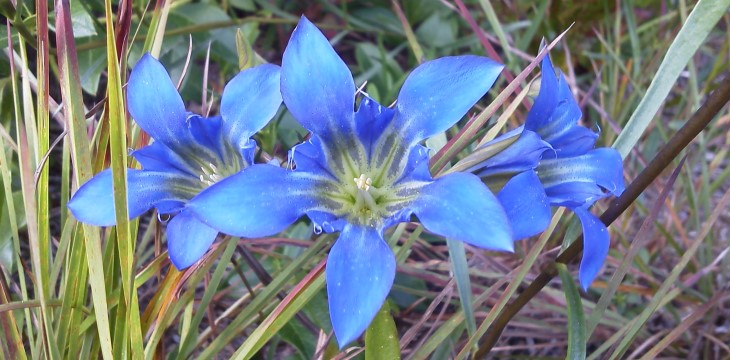The State We're In
Pine Barrens plants – the rare, the weird and the wonderful
By Alison Mitchell, Co-Executive Director
If you look at the New Jersey Pine Barrens from the road or the air, it may seem to live up to its name – miles upon miles of endless pitch pine forest. But the million-acre-plus region spanning seven counties in South Jersey is not just pines … and it’s anything but barren.
In fact, one thing that makes the Pine Barrens such a fascinating place is its surprising variety of plant life. Some Pine Barrens plants have unusual characteristics, such as being carnivorous, many are exceptionally beautiful, and others are so rare as to be found no place else on Earth!
“Endemic” species are those that occur only in the Pine Barrens of New Jersey, and they’re a compelling reason to permanently preserve land in this region to protect local, state, national and global biodiversity. If endemic species are destroyed, they’re not only gone from the Pine Barrens but from the entire world!
It appears there are only three true cases of endemic Pine Barrens plants.
One is bog asphodel, a beautiful wildflower in the lily family, with bright yellow flowers. It occurs only in a scarce, specialized habitat: open, boggy fens along slow-flowing creeks or rivers. Although about 70 historic occurrences have been documented, only about 50 still exist. New Jersey Conservation Foundation’s Franklin Parker Preserve and Candace Ashmun Preserve both protect bog asphodel populations.
Another endemic species is Knieskern’s beaked-rush, better known as Knieskern’s beaksedge, a grass-like plant with tiny flowers. The “beaked” part of its name comes from the styles on its fruits, which look like tiny bird’s beaks. Knieskern’s beaksedge was found in a natural setting in undisturbed soil at the Franklin Parker Preserve, after a very hot ecological prescribed burn – perhaps indicating that wildfires in moist lowlands are the key to creating and maintaining beaksedge habitat.
The third endemic Pine Barrens species is referred to as false asphodel. It resembles bog asphodel and grows in the same habitat, but its flowers are white. Recent research suggests that it is a hybrid of two parent species (coastal false asphodel and sticky false asphodel) that long ago had overlapping ranges in the Pine Barrens, but have since retreated. Genetic research is being done to explore false asphodel’s origins.
Endemics are only one category of plant rarity. Other species can be rare from a global perspective but somewhat common in the Pine Barrens.
A prime example is Pine Barrens gentian, a beautiful and iconic species with fall blossoms usually in blues and purples. It’s restricted to rather scarce habitats, and known to occur only in New Jersey, Virginia, North Carolina, and South Carolina. Although the global distribution of these gentians is quite small, New Jersey is a stronghold and there are about 100 populations in our Pine Barrens.
Another species in this category is swamp-pink lilies. With their bright pink flower clusters atop long, slender stems, swamp-pinks are an early spring delight. New Jersey is their global stronghold – 70 percent of the world’s population is here.
Other Pine Barrens plants are common from a global perspective, but rare here – often because the species is at the northern limit of its range. An example is fringed yellow-eyed-grass, a flowering plant with slender grass-like leaves. Its range goes from South Jersey down along the eastern and gulf coast states all the way to Texas. It’s considered “demonstrably secure” globally, but critically imperiled in New Jersey.
Still other Pine Barrens plants are rare both globally and locally. A prominent example is American chaffseed, which has purplish-yellow tubular flowers on a sturdy stalk. Although this plant has been found in 16 eastern states, from Massachusetts to Louisiana, it is nowhere common—having been extirpated in about half of those states and imperiled in all the rest. Only a single natural population remains in New Jersey, down from an original 19 or 20. Also in this category is Pickering’s morning glory, whose petite white flowers grow on trailing vines in Pine Barrens sand dunes.
The Pine Barrens is also home to three groups of native carnivorous plants that trap and eat animal prey, mostly insects – pitcher plants, sundews and bladderworts. While most are not as rare as the other plants mentioned, they’re among the most interesting!
Why did these predator plants evolve to eat animals? The answer is the soil. Pitcher plants, sundews and some bladderworts live in wet, nutrient-poor soils and adapted to get additional nutrition by luring, trapping and digesting insects and small critters.
All of these species highlight the vital importance of land conservation in the Pine Barrens. With so many preserved acres, the region is a relatively safe haven for plants that are rare globally, locally or both. However, threats still come from illegal off-road vehicle traffic, fire suppression, roadside scraping, and other incompatible land uses.
To learn more about Pine Barrens plants, go to https://pinelandsalliance.org/learn-about-the-pinelands/ecosystem/pinelands-plants-overview/plants-of-the-pine-barrens/.
And for more information on preserving New Jersey’s land and natural resources – including rare plants – visit the New Jersey Conservation website at www.njconservation.org or contact me at info@njconservation.org.
About the Authors
Alison Mitchell
Co-Executive Director
John S. Watson, Jr.
Co-Executive Director
Tom Gilbert
Co-Executive Director, 2022-2023
Michele S. Byers
Executive Director, 1999-2021
View their full bios here.
Filter
Get The Latest News
From The Garden State
In the
News

